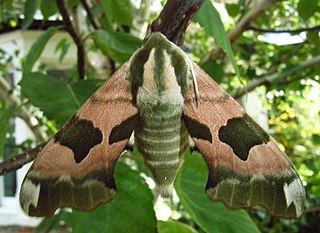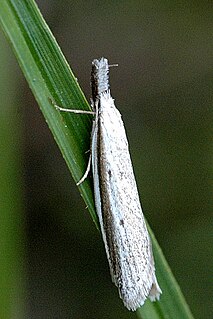
The purple thorn is a moth of the family Geometridae. The species was first described by Johann Siegfried Hufnagel in 1767. It is a species of northern and central Europe. It has a scattered distribution in Britain but is absent from Ireland.

Mimas tiliae, the lime hawk-moth, is a moth of the family Sphingidae. It is found throughout the Palearctic region and the Near East, and has also been identified in eastern Canada. The species was first described by Carl Linnaeus in his 1758 10th edition of Systema Naturae.

Schreckensteinioidea is a superfamily in the insect order Lepidoptera containing a single family, Schreckensteiniidae, or "bristle-legged moths", because of the stout spines on the hindlegs. The superfamily and family were both described by Thomas Bainbrigge Fletcher in 1929. The relationships of this family within the group apoditrysia are currently uncertain. One of the species, the blackberry skeletoniser, is widespread and common across Europe and has been introduced as a biological control to Hawaii, whilst three species of Corsocasis occur in South East Asia.

Nepticulidae is a family of very small moths with a worldwide distribution. They are characterised by eyecaps over the eyes. These pigmy moths or midget moths, as they are commonly known, include the smallest of all living moths, with a wingspan that can be as little as 3 mm in the case of the European pigmy sorrel moth, but more usually 3.5–10 mm. The wings of adult moths are narrow and lanceolate, sometimes with metallic markings, and with the venation very simplified compared to most other moths.

Incurvariidae is a family of small primitive monotrysian moths in the order Lepidoptera. There are twelve genera recognised. Many species are leaf miners and much is known of their host plants, excluding Paraclemensia acerifoliella. The most familiar species in Europe are perhaps Incurvaria masculella and Phylloporia bistrigella. The narrow wings are held tightly along the body at rest and some species have very long antennae.

Cisthene is a genus of lichen moths in the family Erebidae. The genus was erected by Francis Walker in 1854.

Abraxas sylvata, the clouded magpie, is a Palearctic moth of the family Geometridae that was named by Giovanni Antonio Scopoli in 1763.

Cydia nigricana, the pea moth, is a moth of the family Tortricidae. It is found in Europe.

Eupoecilia ambiguella, the vine moth, is a moth of the family Tortricidae. It is found in Europe, China, India, Japan, Korea, Mongolia and the Russian Far East.
Pheia is a genus of moths in the subfamily Arctiinae erected by Francis Walker in 1854.

Eupithecia dodoneata, the oak-tree pug, is a moth of the family Geometridae. The species can be found in Europe. Local occurrences are found in Asia Minor, the Caucasus as well as in Morocco. In the Pyrenees and the Alps, it rises to altitudes of 1000 metres. The species prefers dry oak and oak mixed forests.

Agonopterix ocellana is a species of moth of the family Depressariidae. It is found in Europe and was first described by Johan Christian Fabricius in 1775

Ochropacha is a monotypic moth genus in the family Drepanidae. The genus was first described by Hans Daniel Johan Wallengren in 1871. Its single species, Ochropacha duplaris, the common lutestring, was first described by Carl Linnaeus in 1761. It is found in China (Jilin), Russia, Japan, the Korean Peninsula and from Central Asia to Europe.

Carcina quercana is a species of moth of the family Depressariidae. It is found in Europe. It has been introduced recently in North America, British Columbia and western Washington. It is occasionally known by several common names including oak lantern, long-horned flat-body, and oak-skeletonizer moth.

Pleurota bicostella is a moth of the family Oecophoridae. It is found in the Palearctic realm.

Amphisbatis is a monotypic genus of moths belonging to the family Oecophoridae. The only species is Amphisbatis incongruella. It is found in Europe.

Pseudatemelia josephinae is a moth of the family Oecophoridae. It is found in Europe.

Stigmella aceris is a moth of the family Nepticulidae found in Europe. It was first described by Heinrich Frey in 1857.

Lithostege griseata, the grey carpet, is a moth of the family Geometridae. The species was first described by Michael Denis and Ignaz Schiffermüller in 1775. It is found in most of Europe, from Great Britain and the Iberian Peninsula to the Ural Mountains and further east to central Asia and Transcaucasia, Asia Minor and the Near East.
Cisthene bisigna is a moth of the family Erebidae. It was described by Carlos Berg in 1875 and is found in Patagonia.



















